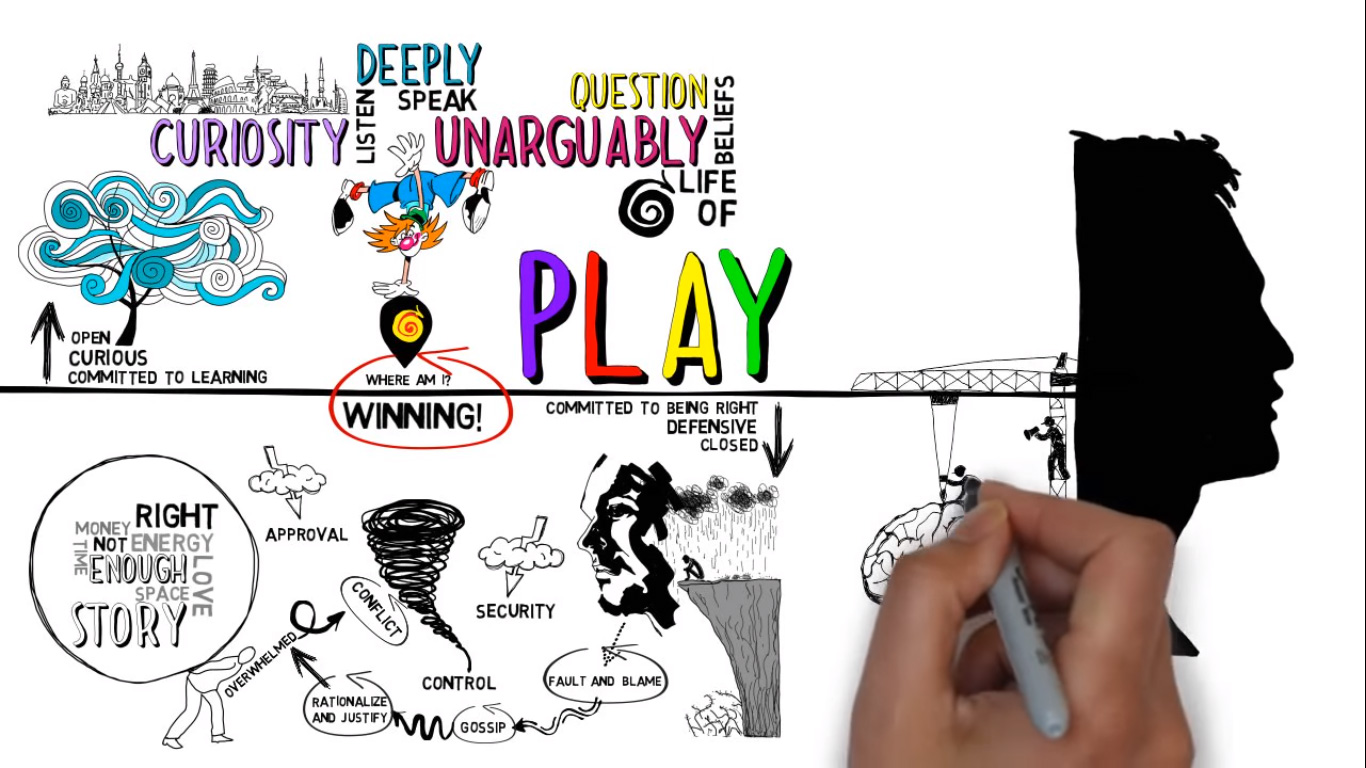Picture this: you are in a meeting and last month’s numbers are a disaster. Things just didn’t work out the way you wanted or expected. Feeling flustered and angry, you start blaming other people for the failure. You complain about the lack of resources and the market situation. You insist that it was the circumstances that messed everything up.
This is a classic example of operating “below the line”.
One of the most powerful leadership tools available to us is a simple black line. At any given time, your thinking and behaviour are either above or below the line. Don’t let the simplicity of the concept fool you – it can be transformational.
If you are above the line, you are:
- Open
- Accountable
- Solution oriented
- Committed to learning
If you are below the line, you are:
- Closed
- Defensive
- In denial
- Committed to being right
When things go wrong or don’t turn out the way we visualised, we tend to slip below the line. Perceiving the situation as a threat, we begin to blame, deny or justify in order to protect our ego. Unfortunately, that doesn’t get us too far and can over time become self-defeating. Which means it is imperative for us to practice above the line leadership.
So, this week, my message focuses on what it means to be above the line and how you can choose to consciously practice this style of leadership. The keyword here is “choose”. While your default response may be below the line, it isn’t terribly difficult to climb over that line into a more positive, inspiring leadership zone – if you really want to, that is.
One of the most common complaints people have against managers is that they blame others to cover up their own mistakes and avoid embarrassment. Other issues include giving team members the silent treatment and badmouthing them to other employees.
These are the typical behaviours of someone who is operating below the line – obviously, they leave people disillusioned and uninspired. If you criticise everyone, refuse to take responsibility, and are constantly stuck in problem mode, then how can your team possibly be excited and motivated about work?
So, what does above the line leadership look like? Let’s go back to the scenario I mentioned earlier: you are at a meeting and last month’s numbers are a disaster. Things just didn’t work out the way you wanted or expected. You begin by taking responsibility and exploring where you may have gone wrong. Then you move into solution mode, figuring out what you learned from this situation and how you can overcome the challenge that lies ahead.
Your willingness to introspect and grow, combined with a forward-looking attitude, can help you create a genuine achievement culture. This will propel your team to be more resourceful and innovative – not to mention happier. Plus, you will also feel more positive and engaged. Instead of getting trapped in a victimhood rut, you will be able to take charge, solve problems, and move ahead.
For an excellent depiction of the differences between living above and below the line, watch this short video by the Conscious Leadership Group.
Here are a few ways in which you can shift your mind set and practice leading from above the line:
1. Train yourself
In order to alter your below the line behaviours, you will first need to recognise them. Recall the most recent crisis you faced or mistake you made. How did you respond? Were you defensive? Did you try to justify the situation? Or did you hold yourself accountable and try to solve the problem?
You can extend this exercise to your personal life. For instance, think back to that argument with your spouse which dragged on endlessly because you just couldn’t admit you were wrong. Or how you spent all morning fuming in the car because you were stuck in a terrible traffic jam. What sort of impact did your behaviour have on you, as well as on other people? What could you have done differently?
Also come up with examples where your response was above the line. What kind of effect did that have? What is the main takeaway?
2. Locate yourself
Self-awareness is key to living above the line. Once you become adept at understanding your past behaviour, you can start to analyse your current frame of mind. Mindful leaders make this a conscious part of their lives, as explained in the video I mentioned above.
How are you responding at work right now? What does your thought process look like? Are you above the line, or below it? Ask yourself these questions regularly – and especially during challenging times. As soon as you become aware that you have slipped below the line, you can start working to pull yourself up.
3. Switch from “them” to “me”
In the middle of a tough situation, pay attention to your language. Are you hearing a lot of “them”, “they” and “you”? For example, “It’s their fault” or “You dropped the ball on this”. This is a clear indication that you are below the line. Instead, switch your language to use “I” and “we”. This shows that you are taking responsibility, puts you in control of the situation, and builds the spirit of collaborative problem solving.
4. Be curious
Get over the need to always be right, and be curious instead. Make time to reflect on challenges rather than simply being swept along by them. The next time your plans go awry, have a frank team discussion. Clarify that the meeting isn’t about assigning blame or wallowing – it is about learning from failure.
In Why You Should Always Choose to Go Above The Line, Suzi McAlpine recommends the following questions:
- What have we and I learnt from this?
- Faced with this again, what would we and I do differently and what would we and I do the same?
- What could my part in this outcome be? What’s my responsibility?
- How can I adopt an accountability mindset in this situation?
5. Pass on the learning
As you become more adept at identifying your own above and below the line behaviours, you will start to notice them in your colleagues as well. In certain cases, you may wonder how you can help them become more aware of their own tendency to sink below the line.
Share this tool with your team, explaining how it has played an important part in your own growth. Use the concept to set the right tone at meetings. Of course, the proof lies in the pudding – it is essential that you model the behaviour you are recommending.
You could also ask questions to guide a team member towards greater self-awareness:
- Why do you think that? What are the reasons behind your perspective?
- Are there any other ways to look at the situation?
- Let’s move past the problem – what does that look like?
- How can you move ahead?
6. Appreciate people
In his article Leading from Above the Line, Steven Satterwhite expands the notion of above the line leadership:
It’s a philosophy, a way of being, a way of leading, a sort of leadership mantra that lifts people up, that lights them up, and inspires them to do their best work. This is the starting point for real, authentic leadership.
To build people up and help them feel fulfilled, Satterwhite suggests a simple step: give your team members one minute of your time, whenever possible. Just one minute of focused attention, in which you see them, listen to them, engage with them, and appreciate them. It’s so simple yet so effective. Start right now – and watch the other person light up.
As always, I look forward to your thoughts.









Dear Vivek, thanks for this gem of a blog. I guess majority of people are above-the-line in mindset, but it’s the tough extraneous conditions which force them to think below-the-line. The key as you wrote is to practice “ATL” behaviour. Eventually practice would make you better if not perfect! A big learning for me personally from this. As they say in Indonesian Bahasa, ‘Terimakasih Banyak’.